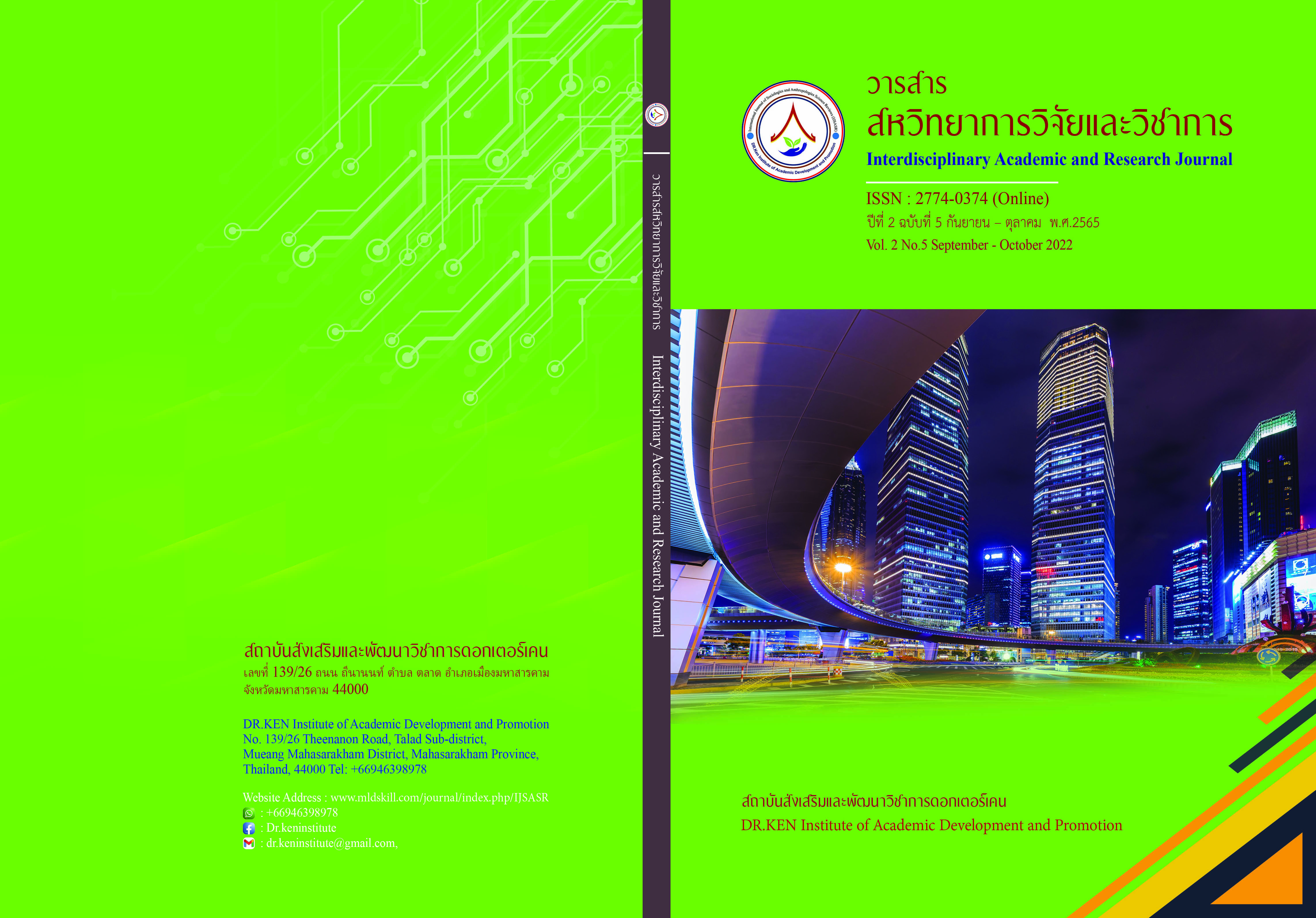The Development of Element’s Happiness in Ongkharak Demonstration School, Srinakharinwirot University
DOI:
https://doi.org/10.14456/iarj.2022.107Keywords:
Development; , Happiness;, Demonstration School; , Srinakharinwirot UniversityAbstract
Happiness in school is another Important element that results in learning. Self-awareness and continuous self-development. However, Nowadays, many factors affect happiness in school. The purpose of this study was to investigates the element of happiness, factors influencing happiness, and finding the guidelines to developing the element of happiness in ongkharak demonstration school, Srinakharinwirot university. This study employed a mixed-methods approach; First, starting from qualitative research and analysis unit with organization. Data were collected with 4 groups of informants, namely (1) 5 administrators, (2) 10 teachers, (3) 10 students, and (4) 5 parents. The interview method was used differently as appropriate of the target group and included contents analysis. Finally, there's quantitative research. Data were collected by census survey with all personnel, divided into 2 groups: (1) operational personnel and (2) academic personnel. A total of 89 patients were assessed using a questionnaire that was subjected to professional scrutiny. To evaluate the research hypothesis, the data were examined using descriptive statistics, and multiple regression statistics. The results showed that, there are 7 elements of happiness in ongkharak demonstration school, Srinakharinwirot university; (1) good health (2) good social support (3) good fun and relaxation (4) good opportunity (5) good spend money (6) good living and (7) good organization. Furthermore, the results revealed that the happiness of the employees were moderate level accounted for 61.80 percent, and the highest percentage of the average score on good social support happiness was 83.38 percent, followed by good opportunity at 75.77 percent, but good health happiness was at a minimum. 57.61 percent of the total. When the factors influencing happiness were examined, it was discovered that emotional and psychological social support (Beta = 0.428) and organizational process plans and policies (Beta = 0.383) had a statistically significant influence on happiness at the level 0.01, which is based on the research hypothesis, and the variables could explain the variation by 33.2 percent (R2 = 0.332) and 30.4 percent (R2 = 0.304), respectively.
References
กมล โพธิเย็น. (2559). การจัดการเรียนรู้เพื่อนําความสุขสู้ผู้เรียน. วารสารศึกษาศาสตร์มหาวิทยาลัยศิลปากร, 13 (2), 121 – 131.
กอปรลาภ อภัยภักดิ์. (2563). บรรยากาศองค์กรแห่งความสุข: คนเบิกงาน งานสำเร็จ. วารสาร มจร มนุษยศาสตร์ปริทรรศน์, 6 (1), 315-331.
จุมพจน์ วนิชกุล วัชรี ชูชาติ และสาโรจน์ เผ่าวงศากุล. (2560). การบริหารการศึกษาเพื่อการพัฒนาการศึกษาเปรียบเทียบในประชาคมอาเซียน. วารสารสารสนเทศ, 16 (2), 13 – 30.
ชนากานต์ นาพิมพ์ ประจักร บัวผัน และ ชัญญา อภิปาลกุล. (2561). คุณลักษณะส่วนบุคคลและแรงจูงใจที่มีผลต่อความสุขในการทำงานของเจ้าหน้าที่สาธารณสุขในโรงพยาบาลส่งเสริมสุขภาพตำบลจังหวัดเพชรบูรณ์. วารสารวิจัย มหาวิทยาลัยขอนแก่น (ฉบับบัณฑิตศึกษา), 18 (4), 154 – 166.
ปกรณ์ รัตนทรัพย์ศิริ และ ธีรพัฒน์ วงศ์คุ้มสิน. (2564). ความมั่นคงทางอารมณ์ ความสามารถในการฟันฝ่าอุปสรรค การเสริมสร้างพลังอำนาจและความสุขในการทำงานของครูโรงเรียนเอกชนสายสามัญ ในอำเภอเมือง จังหวัดเพชรบุรี. วารสารสุทธิปริทัศน์, 35 (3), 155 – 173.
รณยุทธ ขวัญมงคล และอาชัญญา รัตนอุบล. (2563). การพัฒนาความสุขในกองทัพเรือด้วยแนวคิดการเรียนรู้ตลอดชีวิตและการเรียนรู้เพื่อการเปลี่ยนแปลง. วารสารวิชาการโรงเรียนนายเรือด้านสังคมศาสตร์ มนุษยศาสตร์ และศึกษาศาสตร์, 7 (1), 17 – 30.
ศุภณัฐ อินทร์งาม และ อำนาจ ชนะวงศ์. (2562). การพัฒนาระบบการจัดการการศึกษาปฐมวัยที่มีประสิทธิผล สำหรับสถานศึกษาสังกัดสำนักงานคณะกรรมการการศึกษาขั้นพื้นฐาน. วารสารศึกษาศาสตร์ มหาวิทยาลัยบูรพา, 30 (2), 160 – 173.
สำนักงานกองทุนสนับสนุนการสร้างเสริมสุขภาพ. (2554). คู่มือความสุข 8 ประการ. กรุงเทพ: สำนักงานกองทุนสนับสนุนการสร้างเสริมสุขภาพ (สสส.).
อาภากร ราชสงฆ์ กาญจนวัลย์ ปรีชาสุชาติ ภูริทัต สิงหเสม สุภาพร ผลบุญ และณัฐพล บุญทอง. (2563). การเรียนรู้อย่างมีความสุข ของนักเรียนวัยรุ่นในจังหวัดสงขลา. วารสารศึกษาศาสตร์ มหาวิทยาลัยทักษิณ, 20 (1), 103 - 116.
Hernández, M. M., Robins, R. W., Widaman, K. F., & Conger, R. D. (2017). Ethnic pride, self-esteem, and school belonging: A reciprocal analysis over time. Developmental psychology, 53 (12), 2384 – 2396. https://doi.org/10.1037/dev0000434
Ismail, S., Khairuddin, N.S., Alias, N.E., Koe, W., & Othman, R. (2018). An Empirical Analysis of Saving Behavior among Malaysian Employees. International Journal of Academic Research in Business and Social Sciences, 8 (10), 1070 – 1080. http://doi.org/10.6007/IJARBSS/v8-i10/4822
Leung, L. (2020). Exploring the relationship between smartphone activities, flow experience, and boredom in free time. Computers in Human Behavior, 103, 130 – 139. https://doi.org/10.1016/j.chb.2019.09.030
Matthews, R. A., & Ritter, K.-J. (2019). Applying adaptation theory to understand experienced incivility processes: Testing the repeated exposure hypothesis. Journal of Occupational Health Psychology, 24 (2), 270 – 285. https://doi.org/10.1037/ocp0000123
Miles, B. & Huberman, A. M. (1994). Qualitative data analysis: An expanded sourcebook. 2nd editon. Thousand Oaks, CA: Sage Publications.
Proto, E. (2016). Are happy workers more productive?. IZA World of Labor, 315. https://doi.org/10.15185/izawol.315
Przyrembel, M., Vrticka, P., Engert, V., & Singer, T. (2019). Loving-kindness meditation - A queen of hearts?: A physio-phenomenological investigation on the variety of experience. Journal of Consciousness Studies, 26 (8), 95 – 129.
Vidal, R.G., Raga, L.G., & Martín, R.L. (2016). Towards school transformation. Evaluation of a coexistence program from the voice of students and teachers. Journal of New Approaches in Educational Research, 5 (2), 137 – 146. https://doi.org/10.7821/naer.2016.7.177
Downloads
Published
How to Cite
Issue
Section
License
Copyright (c) 2022 Geawalin Ngampiriyakorn, Wattanachai Kwalamthan

This work is licensed under a Creative Commons Attribution-NonCommercial-NoDerivatives 4.0 International License.
Copyright on any article in the Interdisciplinary Academic and Research Journal is retained by the author(s) under the under the Creative Commons Attribution-NonCommercial-NoDerivatives 4.0 International License. Permission to use text, content, images, etc. of publication. Any user to read, download, copy, distribute, print, search, or link to the full texts of articles, crawl them for indexing, pass them as data to software, or use them for any other lawful purpose. But do not use it for commercial use or with the intent to benefit any business.
















.png)


